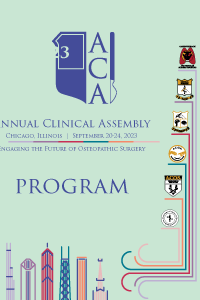General Surgery
BMI and Previous Abdominal Surgeries Do Not Increase the Odds of 36-Month Ventral Hernia Recurrence Following Robotic Abdominal Wall Reconstruction: Is it Time to Rethink the Ideal Patient?
Location: Grandball Room 1-2

Alexandra C. Skoczek, MPH, MS-IV (she/her/hers)
Medical Student
Edward Via College of Osteopathic Medicine - Auburn
Edward Via College of Osteopathic Medicine - Auburn
Huntsville, AL, United States
Primary Presenter(s)
Introduction/Purpose: BMI’s greater than >40 kg/m2 have previously been reported to increase complications following open ventral hernia repair. Due to increased complication rates preoperative weight loss is typically recommended in obese patients prior to elective hernia repair. In addition to elevated BMI’s, the number of previous abdominal surgeries has been demonstrated to effect ventral hernia recurrence rates making when and how to repair a ventral hernia in a patient with an extensive surgical history a complex decision. Minimally invasive surgical approaches such as laparoscopic and robotic hernia repairs have been shown to have lower rates of recurrence in obese patients and those with large surgical histories, however, literature is limited due to the variety of different surgical techniques that can be chosen. This study aimed to analyze the effects of obesity and abdominal surgeries on 36-month hernia recurrence following robotic abdominal wall reconstruction (AWR) using the transversus abdominis release (TAR) procedure with Poly-4-hydroxybutyrate (P4HB) resorbable biosynthetic mesh underlay for elective ventral hernia repair.
Methods or Case Description: A retrospective review of medical records for patients who underwent robotic AWR for ventral hernia repair between 2015 and 2022 performed by a single surgeon was conducted. For the analysis of recurrence and obesity patients were separated into four groups: healthy (BMI ≥ 18.5 and < 25 kg/m2), overweight (BMI ≥ 25 and < 30 kg/m2), obese (BMI ≥ 30 and < 40 kg/m2), and morbidly obese (BMI ≥ 40 kg/m2). Four groups were analyzed (0, 1-2, 3-4, and 5+ previous abdominal surgeries) for the effects of prior abdominal surgery and 36-month recurrence. Primary outcomes included 36-month recurrence and the length of time between hernia repair and recurrence.
Outcomes: 175 subjects met the inclusion criteria for analysis. A total of 17 patients (9.7%) experienced a recurrence of their ventral hernia within a 36-month follow up period with the average time between surgery and recurrence being seen 9 ± 35 weeks after surgery. 6.2% of patients with a healthy BMI, 5.3% of overweight patients, 11% of obese patients, and 12% of morbidly obese patients experiencing recurrence with no significant difference seen between groups (P = 0.66). No significant difference was seen in the length of time between surgery and recurrence between groups (P = 0.66). In addition, none of the groups showed an increased odds of hernia recurrence at 36 months; healthy (odds ratio 0.671, 95% CI .026 – 3.72, P = .623), overweight (odds ratio 0.481, 95% CI .067 – 1.84, P = .317), obese (odds ratio 1.41, 95% CI 0.511 – 4.15, P = .489), and morbidly obese (odds ratio 1.46, 95% CI 0.376 – 4.55, P = .556). When analyzing the effects of prior abdominal surgeries, no significant difference was seen between the four groups with the highest rate of recurrence (12%) seen in patients with 5+ prior abdominal surgeries (P = .80). No significant difference was seen between groups when analyzing time between surgery and recurrence (P = .76) and no group showed a significantly increased odds of recurrence.
Conclusion: No significant difference in recurrence rates and length of time between surgery and recurrence was seen between patients of different BMI’s and number of previous abdominal surgeries. Elevated BMI and previous abdominal surgeries were not seen to significantly increase the odds of recurrence at 36-month following robotic AWR with P4HB mesh. This suggests robotic AWR with P4HB mesh may be a reliable surgical technique in obese patients and patients with a complex surgical history to minimize post operative complications. However, this study was limited in sample size and did not compare different surgical techniques. Future studies with a larger population and a variety of techniques will be needed to evaluate if robotic hernia repairs with this technique is the preferred method when compared to open and laparoscopic methods.
Methods or Case Description: A retrospective review of medical records for patients who underwent robotic AWR for ventral hernia repair between 2015 and 2022 performed by a single surgeon was conducted. For the analysis of recurrence and obesity patients were separated into four groups: healthy (BMI ≥ 18.5 and < 25 kg/m2), overweight (BMI ≥ 25 and < 30 kg/m2), obese (BMI ≥ 30 and < 40 kg/m2), and morbidly obese (BMI ≥ 40 kg/m2). Four groups were analyzed (0, 1-2, 3-4, and 5+ previous abdominal surgeries) for the effects of prior abdominal surgery and 36-month recurrence. Primary outcomes included 36-month recurrence and the length of time between hernia repair and recurrence.
Outcomes: 175 subjects met the inclusion criteria for analysis. A total of 17 patients (9.7%) experienced a recurrence of their ventral hernia within a 36-month follow up period with the average time between surgery and recurrence being seen 9 ± 35 weeks after surgery. 6.2% of patients with a healthy BMI, 5.3% of overweight patients, 11% of obese patients, and 12% of morbidly obese patients experiencing recurrence with no significant difference seen between groups (P = 0.66). No significant difference was seen in the length of time between surgery and recurrence between groups (P = 0.66). In addition, none of the groups showed an increased odds of hernia recurrence at 36 months; healthy (odds ratio 0.671, 95% CI .026 – 3.72, P = .623), overweight (odds ratio 0.481, 95% CI .067 – 1.84, P = .317), obese (odds ratio 1.41, 95% CI 0.511 – 4.15, P = .489), and morbidly obese (odds ratio 1.46, 95% CI 0.376 – 4.55, P = .556). When analyzing the effects of prior abdominal surgeries, no significant difference was seen between the four groups with the highest rate of recurrence (12%) seen in patients with 5+ prior abdominal surgeries (P = .80). No significant difference was seen between groups when analyzing time between surgery and recurrence (P = .76) and no group showed a significantly increased odds of recurrence.
Conclusion: No significant difference in recurrence rates and length of time between surgery and recurrence was seen between patients of different BMI’s and number of previous abdominal surgeries. Elevated BMI and previous abdominal surgeries were not seen to significantly increase the odds of recurrence at 36-month following robotic AWR with P4HB mesh. This suggests robotic AWR with P4HB mesh may be a reliable surgical technique in obese patients and patients with a complex surgical history to minimize post operative complications. However, this study was limited in sample size and did not compare different surgical techniques. Future studies with a larger population and a variety of techniques will be needed to evaluate if robotic hernia repairs with this technique is the preferred method when compared to open and laparoscopic methods.

